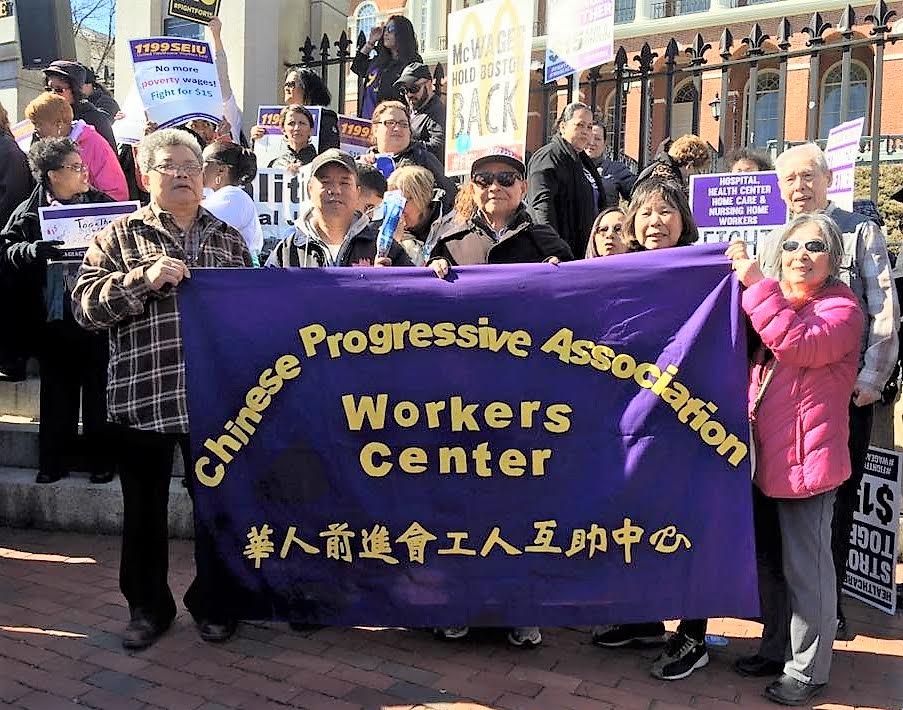By Suzanne Lee and Lydia Lowe
Much is being made of a lawsuit alleging discrimination against Asian American applicants to Harvard University in order to reinforce the narrative that race should no longer be a factor in the admissions process. Plaintiffs allege that Asian American applicants with top scores for academics, test results and extracurricular activities were nonetheless admitted at lower levels than applicants of other races, when factors such as “personality” were taken into consideration. The suit is led by Students for Fair Admissions, a conservative organization that has opposed affirmative action programs on behalf of white applicants in the past.

Workers demand $15/hour minimum wage in Boston(file photo).
The narrative that Asian Americans are the racial minority group that has pulled itself up by the bootstraps without government assistance is known as the Model Minority Myth; it has been deliberately promoted since the 1960s in opposition to policies designed to correct racial inequities. Asian Americans need to read our own history to remember that it was the Third World strikes of the post-Civil Rights era that opened up university admissions for communities of color across the country. Asian Americans in college rose from 16,000 nationwide in 1960 to 250,000 in 1980.
So, why are Asian Americans “over-represented” in elite universities today, and does this justify removing Asian Americans as a disadvantaged group?
Asian Americans are a complex racial category, with roots from many different countries, with a bi-polar class makeup of rich and poor. Today, geopolitical changes in Asia and shifts in immigration policy that give advantage to the wealthiest emigrants have created a new swell of the Asian American upper class. This sector is flocking to private prep schools and hyper-focused on gaining admissions to the elite universities. Meanwhile, the children of Chinese, Cambodian and Vietnamese laborers struggle like many of their Black and Latino counterparts and face growing poverty levels.
The polarized class makeup of Asian Americans is why the disaggregation (or separation) of Asian American data by ethnicity and geography, as well as a per capita analysis, is critical to understanding inequality in our communities. It is no wonder that data disaggregation and affirmative action have become hot-button issues for a small but highly visible Tea Party-backed group of conservative elites in the Asian American community. Generalized data touted as the Asian American success story is also distorted by the fact that the population is concentrated in the state of Hawaii and in urban areas with the highest cost of living, and that Asian American households on the average have more wage-earners in the home.
In addition, many Asian immigrants come from nations with a heavy emphasis on entrance exams that determine future opportunities for schooling and employment. It is common for children to spend years in preparation for these grueling exams, which represent the family’s sole opportunity for advancement.
Racial and economic inequality are at an all-time high, which is why there is as much need for special admissions today as there ever was. We are not living in a post-racial world, but in a racist world in which a select few have been admitted to the club on certain days.
Special admissions programs at the universities are essential not only as reparations for the past but to address the worsening inequality today that is rooted in centuries of institutional racism. These programs are most needed by underrepresented Black and Latino communities but also should benefit disadvantaged Asian American students, not the wealthy elite that has become expert at gaming the system.
If, as we suspect, Asian Americans of all class backgrounds face a discriminatory bias known as the Bamboo Ceiling, the real target for elimination should be the longest-standing historical preference in university admissions—the category of “legacy” admissions that perpetuates white privilege by giving top advantage to the families of alumni. The Harvard Crimson reported last year that the Class of 2021 is made up of over 29 percent legacy students, who are three times more likely to get into the school than those with no family ties. Meanwhile, the New York Times found that, at 38 elite colleges, there are more students from the top one percent than from the entire bottom 60 percent of the economic ladder.
Asian Americans who are committed to civil rights for all must keep our focus on fighting racial and economic inequality together with other communities of color. We cannot allow ourselves to be used as a wedge by conservative forces seeking to undermine educational access, employment opportunities, and a political voice for communities of color.
About the authors
Suzanne Lee is a former principal of the Josiah Quincy Elementary School and earned her Masters at Harvard University Graduate School of Education. Lydia Lowe is a graduate of UMass/Boston, the only four-year Asian American and Native American Pacific Islander-Serving Institution in the Commonwealth.